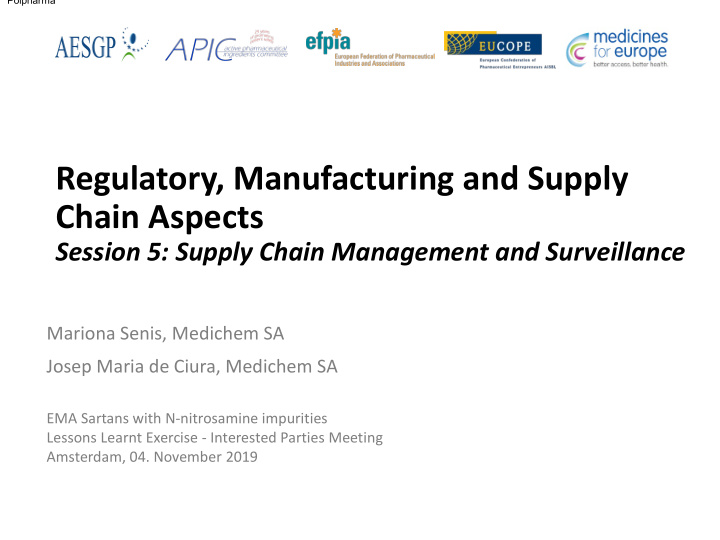



Polpharma Regulatory, Manufacturing and Supply Chain Aspects Session 5: Supply Chain Management and Surveillance Mariona Senis, Medichem SA Josep Maria de Ciura, Medichem SA EMA Sartans with N-nitrosamine impurities Lessons Learnt Exercise - Interested Parties Meeting Amsterdam, 04. November 2019 1
Medicines are well Developed, Manufactured and Available for Supply Quality is built into the processes Raw API starting API Drug Finished Pharmacy / (Drug Substance) Product Product Material material Patient Quality Agreements between actors in the supply chain => GMP responsibilities => Quality measures of each party 3
Fundamental Strategies in Operations: Recognise Risks are Managed at a Desired Level • Achieving anticipated quality • Using good science low high • Realising solid risk assessment • Implementing Good Manufacturing Practices Severity = Probability • Ensuring quality targets are achieved • Applying defined controls as necessary Detectability Risk • Improving with preventive actions Managing Risks • Analysing on a solid understanding of root causes if something happens Quality Risk Management: ICH Q9 briefing pack https://ich.org/page/briefing-pack 4
The Regulatory Framework has Established Controls: All European Pharmaceutical companies are bound to fulfill, otherwise they can not operate Good Manufacturing Practices Regulatory Commitments Material Management EU-GMP, Part I, 5; Part II, 7 Specification setting Quality Control ICH Q6A/ICH Q6B EU-GMP, Part I, 6; Part II, 11.2 Solvent Recovery Impurity control EU-GMP, Part II, 14.4 ICH Q3 series Distribution EU-GMP, Others, GDP; Part II, 9,10,17 Mutagenic Impurities Quality Agreements ICH M7 EU-GMP, Part I, 7; Part II, 16 Self Inspections EU-GMP, Part I; 9; Part II, 2.4 Regulatory Approval Regulatory Inspections 5 ICH: International Council for Harmonisation: implemented into the EU regulatory framework EU-GMP Part I for medicinal products; EU-GMP Part II for Active Ingredients
The Regulatory Framework and Established Controls already exists: Is there a need for updated guidance? Quality Systems Supplier Supply Chain and Control Management Management Process Process Processes (examples) • Impurities are 1.Selection • Quality Monitoring controlled at the 2.Qualification & • Change validated level Development Management • Cleaning validation 3.Monitoring & • Awareness of in shared factifies Managing hazards, assessment and control of risks • Quality Risk Management (QRM) is established ⇒ Companies use QRM to identify hazards and mitigate the risks ⇒ Subjected to regulatory oversight 6
Applied Quality Risk Management in Operations: Risks Can be Controlled - Residual Risk Remains GMP GMP GMP GDP GDP GDP GDP Raw API starting API Drug Finished Pharmacy / Material material (Drug Substance) Product Product Patient • Analytical techniques and specifications are appropriate => New knowledge, experience and expectations will be taken into account • Processes are controlled and monitored => Procedures assure the recovered materials meet suitable specification • Recognise risks at a desired level => Adoption of the risk control is possible - A zero risk scenario is not possible 7 Mana ging
• Quality Agreements between actors in the supply chain define the GMP responsibilities of each party • Analytical techniques and specifications are appropriate • Processes are controlled and monitored • Recognise risks at a desired level: zero risk scenario is not possible • Inspections & guidelines ensure the regulatory oversight in the supply chain 8
EU API MANUFACTURERS APPROACH API manufacturers are systematically performing genotoxic assessments that includes nitrosamines (as structural alerts) in the scope of evaluation, according to ICH M7 Adoption of EMA request for risk evaluation of the presence of nitrosamine impurities: API manufacturers have adopted the guide for RA evaluation based on Production process evaluation Starting materials sourcing Solvents and reagents 9
• Understanding of formation and purge of impurities • Cross contamination (equipment); cleaning validation/ dedicated API equipment production process • Process knowledge • Supplier commitment for changes communication • Supplier evaluation and risk assessment Starting • On site audits materials • Supplier evaluation • In house recovery Raw Material • External recovery; supplier information and on site audits (Solvents/Reag Catalysts) RISK ASSESSMENT 10
RISK ASSESSMENT OUTPUT NO RISK/ ACCEPTABLE CONFIRMATORY RISK REDUCTION LEVEL OF RISK TESTING • Need to test before • No action required • Routine test final evaluation implementation • Method • Process change development and • Variation validation Key point is prioritization based on real risk, focusing on high risk API: - Sartans - Other APIs with tetrazole ring - Amines and nitrites concomitantly used in the synthesis - Other APIs 11
Recommend
More recommend